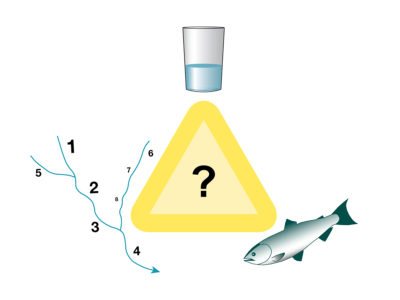Making Key Policy Decisions in Advance of Droughts
Part 6 in a Series on Improving California Water Rights Administration and Oversight for Future Droughts

It’s hard to respond effectively to a crisis when you don’t have clearly defined priorities. This is true for sudden-onset crises, like floods and wildfires, and also for slow-onset crises, like droughts.
My recent posts have explored why the State Water Resources Control Board (Board) should develop a contingency-based framework to support its drought decisions and how it might go about doing this. As I’ve flagged previously, complementary efforts to reduce uncertainty and lay the groundwork for more effective drought response are also crucial.
The Board should be targeting its drought response strategies to meet the water management priorities that flow from state and federal law. But it has not yet made key policy decisions about how to implement these priorities—or how to reconcile them with one another.
Major outstanding questions include:
1. How will the Board implement water right curtailments during times of water shortage? With increasingly frequent and intense droughts on the horizon, clear procedures for determining both when curtailments are needed and who must curtail are critical. As I mentioned in my last post, efforts to implement curtailments during past droughts were uneven and relied on relatively informal, coarse-scale analyses of water availability for broad classes of water rights. The Board needs to develop clear, more formal, and more detailed curtailment procedures that explicitly account for hydrologic connectivity and incorporate non-water-right priorities, including those described below.
2. How will the Board protect ecosystems during droughts? Existing ecosystem protections weren’t implemented adequately during past droughts. Why? A major reason is that, often, the Board has not decided how to operationalize broadly applicable legal requirements—such as state and federal legal requirements to protect endangered species, water quality, and public trust resources—in specific watersheds. For example, many biologically important waterways lack clear, quantitative instream flow requirements to protect fish and freshwater ecosystems. Where flow requirements do exist, they frequently don’t account for the full range of relevant hydrologic conditions, including severe or prolonged droughts. The Board is making progress in developing flow requirements for a number of stream systems around the state, but the immense scale of the work left to do suggests reasonable interim flow requirements are needed until tailored, stream-specific guidelines are available.
3. How will the Board protect human health and safety during droughts? During the recent drought, the Board experimented with, but did not reach firm conclusions about, how to reconcile minimum health and safety needs (such as for drinking, cooking, and basic sanitation) with water-right and wildlife priorities in the context of curtailments. If drawn too broadly, a carve-out from curtailment for health and safety needs could reward public water suppliers that have not worked diligently to improve supply reliability by allowing them to jump to the front of the priority line during times of shortage. But a carve-out that is too narrow could penalize those that have tried to increase supply reliability but run into insurmountable financial or other challenges. Because California cannot fallow its residents (and diverters of all water right priorities will continue to need to meet minimum health and safety needs for water during future droughts), the Board needs to develop an explicit approach to defining and addressing these needs.
These policy decisions won’t be easy. They are likely to be substantively challenging and politically controversial, requiring the Board to make critical judgment calls about how to reconcile multiple important, and potentially conflicting, legal requirements. Although making these decisions will improve predictability (and sustainability) in the long term, water users who think they stand to lose relative to the status quo are likely to put up strong resistance in the near term. (A case in point: A raft of litigation has greeted the Board’s recent adoption of flow requirements for the San Joaquin River and its major tributaries.)
Nonetheless, avoidance is not a viable strategy. If the Board does not make these policy decisions proactively and deliberately in advance of droughts, it will make them passively or on an ad-hoc basis during each new drought emergency.
Using non-emergency public processes to make key policy decisions in advance of droughts will have many benefits. Most obviously, it will enable the Board to more effectively implement critical drought response actions during drought emergencies. But it will also enable more meaningful input and feedback from a wide range of stakeholders—including those from marginalized communities who may find it especially difficult to have their voices heard in truncated emergency processes. And, crucially, it will help to head off stakeholders’ due process concerns while giving them notice of how the Board will approach drought decision making. This will both enhance the perceived legitimacy and fairness of the Board’s drought decisions and provide stakeholders with a solid basis for their own contingency planning efforts.
Finally, making key policy decisions proactively will benefit more than just California’s future drought response capabilities. It will improve water rights administration and oversight more broadly. I hope to explore why in a future post.






Reader Comments